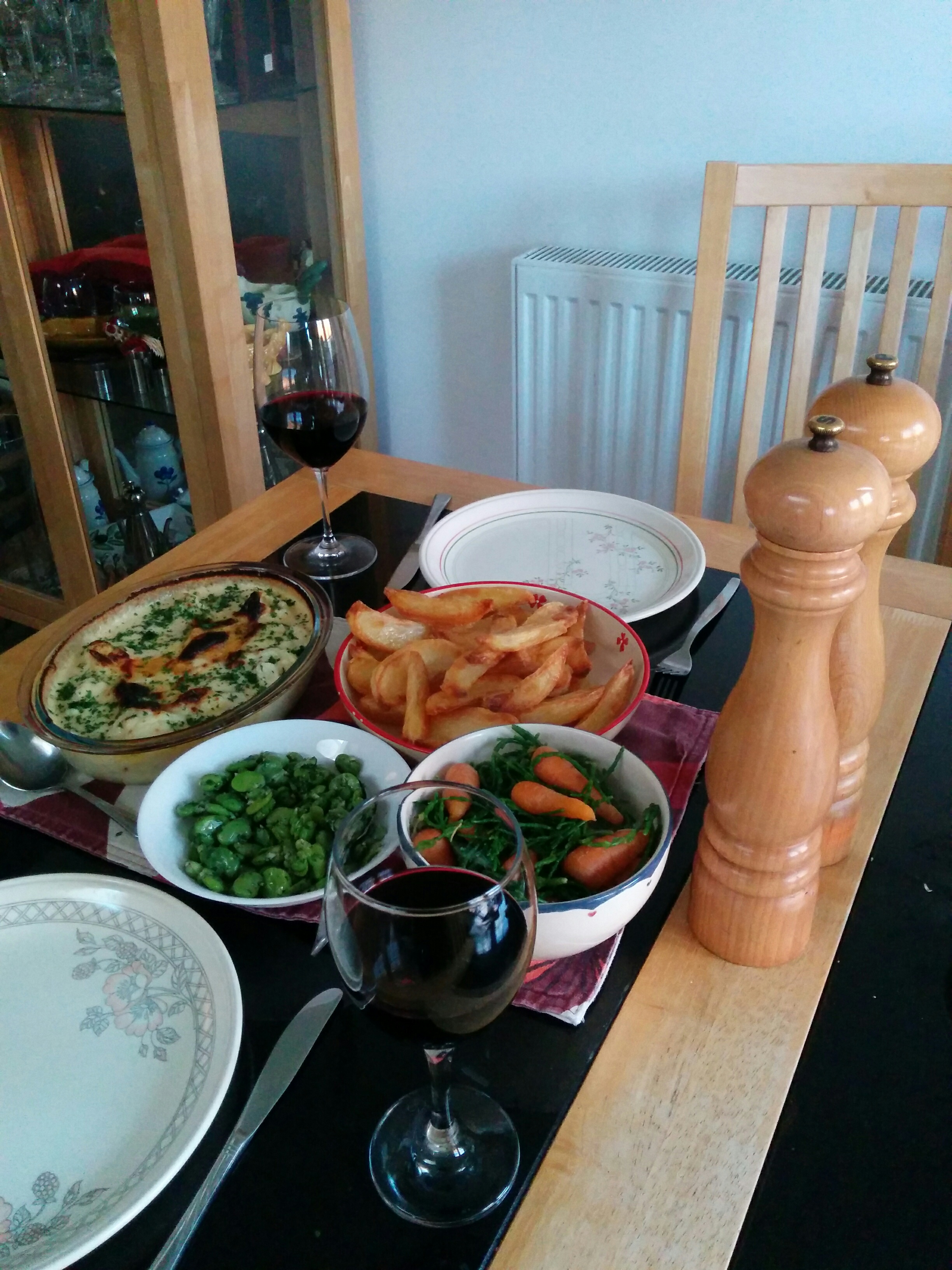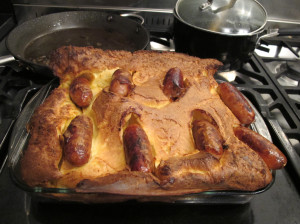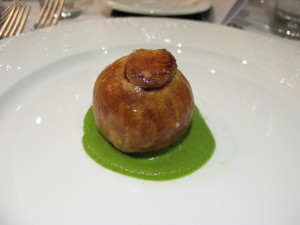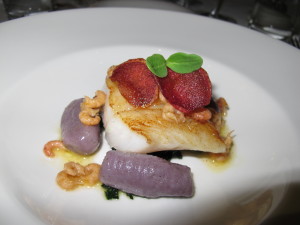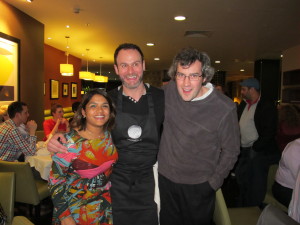When parboiling potatoes for roasting or chips add 15g salt per litre of water.
Category Archives: food
Macaroni cheese recipe
Adapted from https://www.bbcgoodfood.com/recipes/8834/bestever-macaroni-cheese
Ingredients
4 tbsp butter
350g spiral or other short pasta
2 garlic cloves, finely chopped
2 tsp English mustard powder
6 tbsp plain flour
1 litre semi-skimmed milk
250g/to taste mature cheddar/any combination of strong cheese, grated or chopped into small pieces
strong hard cheese, grated for topping
Fresh breadcrumbs for topping
Method
Heat oven to 200C/fan 180C/gas 6.
Boil the pasta for 2 mins less than stated on the pack. Meanwhile, melt the butter in a saucepan.
Add the garlic and mustard, cook for 1 min, then stir in the flour.
Cook for 1 min more, then gradually whisk in the milk until you have a lump-free sauce. Simmer for 5 mins, whisking all the time until thickened.
Take off the heat, then stir in the cheese.
Stir the pasta and some seasoning into the cheesy sauce. Tip into a large ovenproof dish, or 4 individual dishes.
Scatter over the hard cheese, then cover with breadcrumbs, then bake for 20 mins until crisp and golden. Can be frozen before baking – defrost thoroughly before cooking.
Variations
Additions to the sauce: leeks/onions, bacon
Cauliflower cheese
I used this Nigella cauliflower cheese recipe but I changed the Red Leicester to a smaller amount of Gruyère. It worked really well.
Gammon in Coke
Made this last night with a 1.8kg unsmoked gammon joint. Simmered it for 2 hours in the Coke, then put the glaze on, but burnt most of the glaze sadly. So be careful when putting the glazed joint in the oven.
Toad in the hole
I’ve made this twice now, using Nigella’s toad in the hole recipe in Kitchen, except that I don’t make patties out of the sausages. I do fry the sausages to colour them beforehand though.
EDIT: 14 Apr 2014
Best not made in the lasagne dish. Pyrex dish gives a better rise. I baked it for 35 mins only; the one in the photo is a little too dark.
EDIT: 05 Oct 2015
If there is a delay between making the batter and cooking, don’t put the batter in the fridge. It will make it too cold when it hits the hot fat and it won’t rise. Also preheat the oven to 225C beforehand but turn it down to 200C when the batter actually goes in.
Tom Kerridge at Opus
Foccacia
This recipe is from Paul Hollywood’s How To Bake, which is turning out to be an excellent investment; not a single dud recipe so far. I’ve made it quite a few times recently and it’s turned out great every time. I expect the secret of its success is to use the very best olive oil possible.
Nigella’s greek lamb stew
I watched this last night on a Nigella Bites repeat on the Good Food channel. It occurred to me that I’ve made it several times over the past few years – it’s always a winner for feeding friends – but have never blogged about it. This is Nigella’s recipe, from How to Eat:
Ingredients
4 tablespoons olive oil
2.5 kg boned shoulder of lamb, trimmed of excess fat and cut into cubes about 6 x 3 cm
750g or about 5 medium onions, sliced finely
Salt
4 garlic cloves, minced
2 celery stalks, minced
Leaves from 4 thyme sprigs
1 teaspoon dried oregano
3 bay leaves
2 carrots, peeled, halved lengthways, and then halved across
3 400g tinned chopped tomatoes
300ml lamb stock or water
1 bottle dry white wine
Freshly ground black pepper
500g ditalini or other small tubular pasta
300g feta cheese
finely chopped parsley, oregano or basil leaves
Directions
Preheat the oven to 160C.
Into the largest saucepan or casserole you have that will go into the oven, pour 3 tablespoons of the oil. Brown the meat in batches over high heat and remove with a slotted spoon to a plate nearby. You may need more oil as you do this. The onions will certainly need it, so pour the remaining oil or add more, add the onions, sprinkling a little salt over them and cook then until soft and translucent. Add the garlic, celery, thyme, and oregano. After a couple of minutes or so, when the smell of garlic wafts up, remove half the mixture. Add the meat to the mixture in the pan, cover with the remaining half, add the bay leaves, carrots, tomatoes, stock and wine. I use a big but flattish casserole and this amount of liquid covers the meat, but if you find you need more liquid, add water- you want a lot of liquid, because you will, eventually, be cooking some pasta in it. Bring to a boil, remove scum, and let bubble for about 3 minutes. Then cover, transfer to the oven, and bake for about 2 to 2 1/2 hours, or cook on a very low heat. The meat should be tender and yielding. Remove the carrots (and eat, cook’s treat) and bay leaves, too, if you want, and season, to taste, with the salt and pepper.
Of course you can proceed to the final stage now, but I am presuming you’re not going to. In which case, let the stew cool and keep it in the refrigerator until you want it. Skim the fat off the top, and do remember to take it out of the refrigerator a good 1 to 2 hours before you cook it again. You can reheat this in the oven, but because the pasta will be put in on the stove, I tend to heat it there. Make sure the stew is piping hot. Meanwhile, bring a large pot of water to a boil. When it boils, add the salt and then pasta. Cook this until it’s nearly but not quite cooked; it should have a couple of minutes still to go.
Then drain the pasta and add it quickly to the bubbling juices in the casserole, making sure first that there are enough bubbling juices. You don’t want the meat to be drowned, but you want enough for the pasta to be covered. The pasta will absorb some of the liquid as it finishes cooking, of course.
In a couple of minutes, the pasta should be cooked. Crumble some feta and put in a bowl with the chopped parsley, oregano, or basil. Stir to combine and then leave the spoon with it, so that people can sprinkle the herb-spiked cheese over the stew as they wish. Ladle the stew into shallow soup bowls.
My adaptations:
I only use 2 tins of tomatoes and I double the amount of garlic. I leave out the pasta if it’s just for Mark and myself as he’s not that keen but it’s good to add the pasta for guests as they all seem to love it. Be prepared to add more water/stock with pasta though as it absorbs liquid all the time it’s in the stew.
Crunchy new potatoes and creamy horseradish dip
The potatoes are adapted from a BBC Good Food recipe. I made them to accompany homemade smoked trout. I served them together with undressed salad leaves.
Boil new potatoes until they are done (about 10 mins). Drain and allow all steam to evaporate. Place on a greaseproof sheet lightly crush, drizzle with olive oil, sprinkle with salt and gently toss. Bake on a greaseproof sheet on an oven tray at 175C with fan for 15-20 mins or until there are lots of crispy brown edges. These can be flavoured with paprika and the like.
10 Mar 2013
If the new pots are large enough for it to be practical, after cooking and cooling cut in half and score as you would a mango hedgehog. Cook with the scored side facing downwards for about 10 mins, then turn over to brown the skin side.
The dip was adapted from a Jamie Oliver recipe. I wanted a condiment to eat alongside rather than a pate which incorporated the smoked trout. So I put 125g cream cheese, 2 heaped tsp grated horseradish (not sauce), fried onions (I had no chives) and lemon juice into the mixer. I seasoned with pepper. It turned out really well but a little too lemony; you don’t need all the juice of half a lemon so start with half of that.
Poussin
We were given a Gressingham Spatchcock Poussin today. It came in a four pepper seasoning. I noticed that glucose syrup was listed in the ingredients so I thought, why not go the whole hog and give it a Chinese marinade? So, using a Ken Hom recipe as a template I mixed
minced ginger
1 tsp groundnut oil
dark soy sauce
chilli bean sauce
onion powder
and pushed it under the poussin skin. Then I baked in the oven at 175C without fan, aiming for the temperature of the thickest part of the breast to reach 60C (as per Heston’s roast chicken recipe). It actually got to about 65 so was very slightly overcooked but still very nice indeed, as was the rest of the bird. I will definitely cook poussin again, and will also ask the butcher to spatchcock (and perhaps halve) a whole chicken too.
